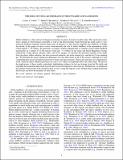THE ROLE OF STELLAR FEEDBACK IN THE DYNAMICS OF H II REGIONS
Author(s)
Lopez, Laura A.; Krumholz, Mark R.; Bolatto, Alberto D.; Prochaska, J. Xavier; Ramirez-Ruiz, Enrico; Castro, Daniel; ... Show more Show less
DownloadLopez-2014-THE ROLE OF STELLAR.pdf (2.125Mb)
PUBLISHER_POLICY
Publisher Policy
Article is made available in accordance with the publisher's policy and may be subject to US copyright law. Please refer to the publisher's site for terms of use.
Terms of use
Metadata
Show full item recordAbstract
Stellar feedback is often cited as the biggest uncertainty in galaxy formation models today. This uncertainty stems from a dearth of observational constraints as well as the great dynamic range between the small scales (lsim1 pc) where the feedback originates and the large scales of galaxies [greater-than or equivalent to]1 kpc) that are shaped by this feedback. To bridge this divide, in this paper we aim to assess observationally the role of stellar feedback at the intermediate scales of H II regions (~10-100 pc). In particular, we employ multiwavelength data to examine several stellar feedback mechanisms in a sample of 32 H II regions (with ages ~3-10 Myr) in the Large and Small Magellanic Clouds, respectively. Using optical, infrared, radio, and X-ray images, we measure the pressures exerted on the shells from the direct stellar radiation, the dust-processed radiation, the warm ionized gas, and the hot X-ray-emitting gas. We find that the warm ionized gas dominates over the other terms in all of the sources, although two have comparable dust-processed radiation pressures to their warm gas pressures. The hot gas pressures are comparatively weak, while the direct radiation pressures are one to two orders of magnitude below the other terms. We discuss the implications of these results, particularly highlighting evidence for hot gas leakage from the H II shells and regarding the momentum deposition from the dust-processed radiation to the warm gas. Furthermore, we emphasize that similar observational work should be done on very young H II regions to test whether direct radiation pressure and hot gas can drive the dynamics at early times.
Date issued
2014-10Department
MIT Kavli Institute for Astrophysics and Space ResearchJournal
Astrophysical Journal
Publisher
Institute of Physics/American Astronomical Society
Citation
Lopez, Laura A., Mark R., Alberto D. Bolatto, J. Xavier Prochaska, Enrico Ramirez-Ruiz, and Daniel Castro. "THE ROLE OF STELLAR FEEDBACK IN THE DYNAMICS OF H II REGIONS." The Astrophysical Journal 795:121 (2014 November 10), p.1-18. © 2014 American Astronomical Society.
Version: Final published version
ISSN
1538-4357